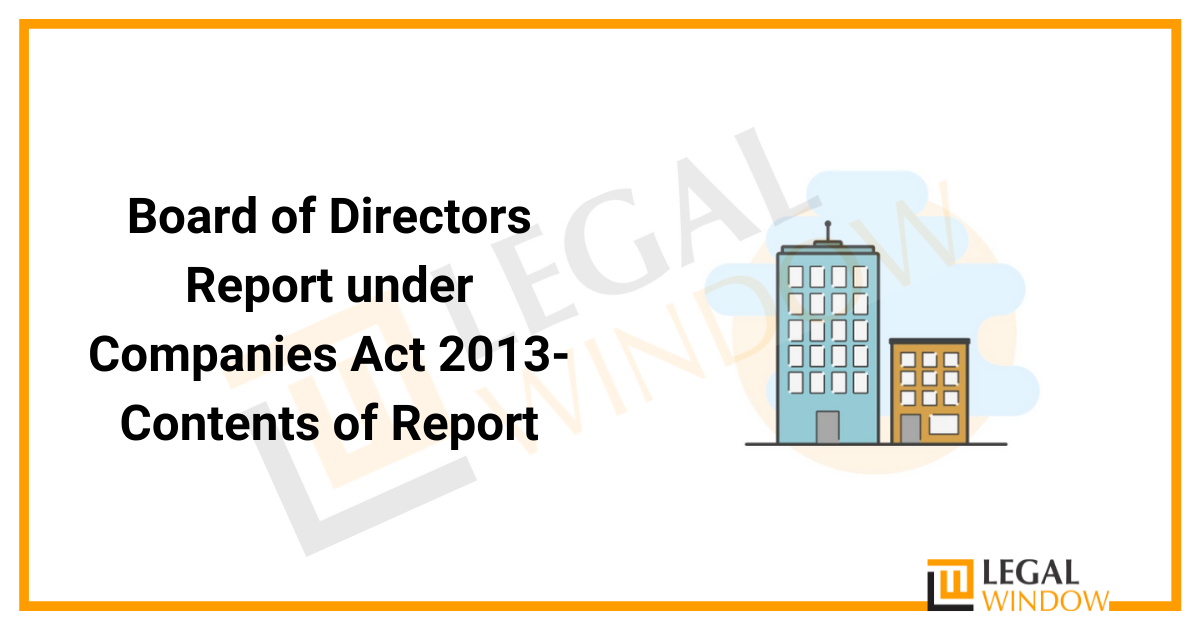Board of Directors Report under Companies Act 2013- Contents of Report
- March 23, 2022
- Compliance

Financial reporting is required for businesses since it offers information on a company’s current state as well as its compliance with financial, corporate social responsibility, and accounting requirements. At the conclusion of each fiscal year, public and private limited firms must produce a financial document known as the Board of Directors Report under Companies Act 2013. Further, the directors’ report is the report generated by the company’s Board of Directors and should be appended to each financial statement. Moreover, It describes the company’s financial situation.
Board of Directors under Companies Act 2013
A Board of Directors (B of D) is a group of persons who represents shareholders. Further, The board of directors is a governing body that meets on a regular basis to establish business management and oversight regulations. Every public corporation is required to have a board of directors.
Board Meetings under Companies Act 2013
Board meetings are the highest-level meetings, attended by board members or their representatives. Moreover, the manner in which we conduct board meetings speaks a great deal about how we run the company. Further, successful businesses use board meetings to establish and enhance critical business strategies. Because a company is only a legal entity, it lacks the ability to act or make decisions. Furthermore, the board of directors serves as the company’s representative, performing actions and making decisions. Moreover, they oversee management, offer fiduciary oversight, and keep an eye out for unwarranted risks or compliance issues. Further, they can also approve and monitor global budgets, as well as make significant executive hires and dismissals.
Board of Directors Reports under Companies Act 2013
The Director’s report is a financial document generated by the Board of Directors that is required by the Companies Act, 2013 for bigger limited companies to file at the end of the fiscal year. Further, Financial reporting is an important aspect of business that outlines the status of the firm and its adherence to a set of financial, accounting, and corporate social responsibility requirements. In this post, we shall discuss the substance of the Directors’ report.
Need of Board of Directors Reports
- The directors of a business must prepare the directors’ report at the conclusion of each fiscal year, according to Section 134(3) of the Companies Act, 2013. In addition to the boards’ report, also known as the directors’ report, promotes more corporate openness. Further, the information in the directors’ report allows shareholders to make educated decisions. Moreover, the information in the directors’ report assists shareholders in understanding:
- The company’s ability to develop and expand.
- Whether the company’s finances are in excellent shape.
- How the firm is performing inside its market, as well as how the market as a whole is performing.
- Whether the corporation is adhering to accounting standards, financial restrictions, and corporate social responsibility mandates.
The Board of Directors’ Report Applicability
Except for One Person Companies (OPCs) and minor companies, all companies must prepare a directors’ report. According to Rule 8A of the Companies (Accounts) Amendment Rules, 2018, small companies and OPCs must file an abbreviated directors’ report.
Matters Needs to be Covered in Board of Directors Report
The information required in the directors’ report is specified under Section 134(3) of the Companies Act, 2013 and Rule 8 of the Companies (Accounts) Rules, 2014. In their directors’ report, listed firms must provide extra disclosures required by Rule 5 of the Companies (Appointment and Remuneration of Managerial Personnel) Rules, 2014.
Content as per statutes
| Companies Act, 2013 | Companies (Account) Rules, 2014 | Additional Contents for Listing Companies |
| The following information should be included in the board’s report, according to Section 134(3) of the Companies Act, 2013 (‘Act’):
Section 92(3) of the Act requires an annual return extract. |
According to Rule 8 of the Companies (Accounts) Rules, 2014, the board’s report must include the following information: | Section 197(12) of the Companies Act, 2013, requires listed companies to publish the compensation ratio of all directors to the median employee’s remuneration, as well as any other relevant information, in the board’s report. |
| Count of board meetings | The directors must produce the board’s report using the company’s standalone financial statements. | The board’s report shall include the following information, according to Rule 5 of the Companies (Appointment and Remuneration of Managerial Personnel) Rules, 2014: |
| Statement of Directors’ Responsibilities, as required by Section 134(5) of the Act | A second component of the directors’ report must provide a report on the financial situation and performance of all affiliates, subsidiaries, and joint venture firms included in the consolidated financial statements. | The percentage rise in each chief financial officer’s, director’s, chief executive officer’s, manager’s, or company secretary’s salary throughout the fiscal year, if any. |
| Other than those reportable to the Central Government, details on frauds revealed by auditors under Section 143(12) of the Act | The following are some details on energy conservation:
a. The influence of actions made to save energy b. The actions done to utilise alternative energy sources c. The capital outlay for energy-saving equipment d. Contents of a board of directors’ report in accordance with the Companies Act of 2013. |
Increase in the percentage of workers’ median salary in the fiscal year |
| Section 149(6) of the Act requires independent directors to make a statement of their declaration. | The following are some specifics on technology absorption:
a. The efforts taken to absorb technology; and b. The advantages obtained, such as cost savings, product creation, product enhancement, or import substitution. c. In the case of imported technology, i.e. technology imported during the past three years, specifics of the technology imported, year of import, whether the technology has been completely absorbed, and the regions and reasons for non-absorption. |
The number of permanent employees on the company’s payroll. |
| The board’s comments or explanations on every reservation, qualification, or unfavourable disclaimer or remark made by the auditor in their report and, in practise, by the company secretary in their secretarial audit report. | Earned foreign exchange in terms of actual inflows during the course of the year | The reason for the association between corporate performance and a rise in salary on average. |
| Details of guarantees, loans, or investments issued in accordance with Section 186 of the Act | In terms of actual outflows, the year’s foreign exchange outflows | The compensation of the KMP (Key Management Personnel) is compared to the company’s performance. |
| Particulars of agreements or contracts involving related parties, as defined in Section 188(1) of the Act | The highlights or summary of financial data | Variations in the company’s market capitalization and price-earnings ratio as of the end of the current and prior fiscal years |
| The current condition of things at the firm | Any changes in the business’s nature | Other than managerial workers, the average percentile increase in salary was made in the preceding fiscal year. |
| The sums that the corporation intends to carry into reserves, if any. | The names and positions of significant executive people or directors that were appointed or resigned during the fiscal year | The directors’ essential parameters for variable components of pay |
| The amount that the corporation believes should be paid as a dividend, if any. | The names of firms that terminated operations or became joint ventures, subsidiaries, or associate corporations during the fiscal year | The pay ratio of the highest paid director to workers who are not directors but are paid more than the highest paid director during the fiscal year. |
| Between the conclusion of the fiscal year to which the financial statements pertain and the date of the report, if any, material obligations and developments impacting the company’s financial status occurred. | The following information is provided:
a. Deposits accepted during the year; b. Unpaid deposits or unclaimed deposits at the end of the year; and c. Default in payment or repayment of deposits or payment of interest during the year, the number of such defaults and the total amount involved at the start of the year, the maximum during the year, and at the end of the year. |
Affirmation that the compensation is in accordance with the company’s remuneration policy. |
| The preservation of technology absorption, energy, expenditure, and foreign exchange profits in accordance with Rule 8(3) of the Companies (Accounts) Rules, 2014. | Deposits that are not in accordance with the provisions of Chapter V of the Act |
a. Employee designation b. Remuneration c. Nature of employment, whether contractual or otherwise d. Employee experience and qualifications e. Date of commencement of employment f. Age of the employee g. The last employment held by the employee before joining the company |
| A declaration demonstrating the execution and development of a risk management policy, including the identification of risk components that, in the judgement of the boards, may endanger the company’s survival, if any. | The specifics of major and significant directives issued by regulators, tribunals, or courts that will have an influence on the company’s activities in the future, as well as the company’s going concern status | |
| Details on the firm’s policy on Corporate Social Responsibility (CSR) actions conducted during the year, as adopted and developed by the corporation. | The specifics of the adequacy of internal financial controls in relation to the financial statements | |
| A statement describing how the board conducted a formal annual evaluation of its own performance, the performance of its committees, and the performance of individual directors in the case of listed companies and every other public company with a paid-up share capital of Rs.25 crore or more calculated at the end of the previous fiscal year. |
Penalty for failing to prepare the Directors’ Report
- When the board authorises them, the chairman of the corporation shall sign the board’s report or the Directors’ report and its annexures. When the board does not authorise the company’s chairman to sign the report, at least two directors, one of whom must be a managing director, must sign the report. Further, A signed copy of the board of directors’ report should be distributed, issued, or posted on the corporate website.
- When a corporation fails to prepare the board’s report and directors’ report. Then the company must pay a penalty of Rs.3 lakh. And each officer in default must pay a penalty of Rs.50,000.
Summary of Board of Directors’ Report
- The Board’s Report of a One Person Company and a Micro Finance Company shall be prepared on the basis of the company’s stand-alone financial statement, which shall be in a shortened form and contain just the points from 1 to 10.
Signing
- The Board’s report must be signed by the company’s chairperson who has permission from the Board. Further, by at least two Directors, one of whom must be a Managing Director, or by the director if there is only one director.
Takeaway
- The boards’ report, also known as the directors’ report, promotes more corporate openness. Further, the information in the directors’ report allows shareholders to make educated decisions. Moreover, the information in the directors’ report assists shareholders in determining if the firm can develop and flourish. And so it shows to be a vital part for the company’s success.
- For more information about this topic kindly connect to our experts
CS Urvashi Jain is an associate member of the Institute of Company Secretaries of India. Her expertise, inter-alia, is in regulatory approvals, licenses, registrations for any organization set up in India. She posse’s good exposure to compliance management system, legal due diligence, drafting and vetting of various legal agreements. She has good command in drafting manuals, blogs, guides, interpretations and providing opinions on the different core areas of companies act, intellectual properties and taxation.
Categories
- Agreement Drafting (23)
- Annual Compliance (11)
- Change in Business (36)
- Company Law (148)
- Compliance (89)
- Digital Banking (3)
- Drug License (3)
- FEMA (17)
- Finance Company (42)
- Foreign Taxation (6)
- FSSAI License/Registration (14)
- GST (118)
- Hallmark Registration (1)
- Income Tax (199)
- Latest News (34)
- Miscellaneous (164)
- NBFC Registration (8)
- NGO (14)
- SEBI Registration (6)
- Section 8 Company (7)
- Start and manage a business (20)
- Startup/ Registration (126)
- Trademark Registration/IPR (40)
Recent Posts
- Detailed Analysis of Section 179 of the Companies Act, 2013 April 24, 2024
- Maximise Your Tax Savings: Power of Form 12BB April 23, 2024
- Cryptocurrency startups and Regulatory compliance April 22, 2024
About us
LegalWindow.in is a professional technology driven platform of multidisciplined experts like CA/CS/Lawyers spanning with an aim to provide concrete solution to individuals, start-ups and other business organisation by maximising their growth at an affordable cost.








